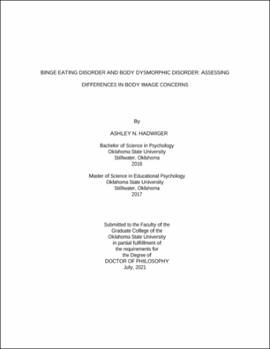| dc.description.abstract | Traditionally, body dissatisfaction - characterized by the overvaluation of weight and shape - has been associated with eating disorders, whereas body dissatisfaction - associated with specific physical features, or features independent of weight and shape (e.g., nose, skin, hair) - has been associated with body dysmorphic disorder. Recent literature suggests individuals with eating disorders may experience dissatisfaction with specific physical features in addition to weight and shape dissatisfaction. Studies that have evaluated the co-occurrence of anorexia or bulimia nervosa and body dysmorphia suggest that individuals experiencing dissatisfaction with weight, shape, and specific physical features are at increased for worsened body image and eating pathology. There is limited research, however, about the co-occurrence of binge eating disorder and body dysmorphic disorder. To better understand how body image disturbance, including dissatisfaction with weight, size, and specific physical features vary between binge eating and body dysmorphic disorders, the present study sought to explore how weight, shape, and non-weight/shape body image concerns varied between college women with binge eating disorder, body dysmorphic disorder, and co-occurring disorders. It was hypothesized that college women who screened positive for body dysmorphic disorder would report significantly more non-weight/shape concerns; women who screened positive for binge eating disorder would report significantly more weight and shape concerns; and college women who screened positive for co-occurring disorders would report significantly more weight, shape, and non-weight/shape concerns. College women (N = 236) completed an online survey including measures assessing for binge eating, body dysmorphia, and weight, shape, and non-weight/shaped related body image concerns, and a demographics questionnaire. A one-way MANOVA demonstrated that college women who screened positive for co-occurring binge eating and body dysmorphic disorders reported all three types of body image concerns significantly and substantially more than college women who screened positive for only one disorder, supporting our third hypothesis. Findings suggest that college women who present with body dysmorphic disorder or binge eating disorder should be screened for all three types of body image concerns to address worsened body image and eating pathology. | |
